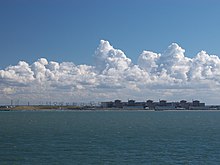| Gravelines Nuclear Power Station | |
|---|---|
 Gravelines Nuclear Power Station | |
 | |
| Official name | Centrale Nucléaire de Gravelines |
| Country | France |
| Location | Gravelines, Nord |
| Coordinates | 51°00′55″N 02°08′10″E / 51.01528°N 2.13611°E |
| Status | Operational |
| Construction began | 1974 |
| Commission date | 13 March 1980 |
| Operator | EDF |
| Nuclear power station | |
| Reactor type | PWR |
| Reactor supplier | Framatome |
| Power generation | |
| Units operational | 6 × 910 MW |
| Make and model | Alstom |
| Nameplate capacity | 5460 MW |
| Capacity factor | 76.9% |
| Annual net output | 38,462 GW·h |
| External links | |
| Website | EDF.com |
| Commons | Related media on Commons |
The Gravelines Nuclear Power Station is a nuclear power plant located in the commune of Gravelines in Nord, France, approximately 20 km (12 mi) from Dunkerque and Calais. Its cooling water comes from the North Sea. The plant consists of 6 nuclear reactors of 900 MW each. In 2017 the plant produced 31.67 TWh of electric energy, 5.9% of French electricity production.[1] Two reactors entered service in 1980, two in 1981, and two in 1985.
The site employs 1,680 regular employees. As of 2 August 2010[update], it became the second nuclear station anywhere in the world to produce over one thousand terawatt-hours of electricity, following Bruce Nuclear Generating Station in Ontario, Canada, which passed that milestone in 2009.[2][3]
The reactors of Units 5 and 6 were initially intended for export to Iran, but the order was cancelled after the Iranian Revolution in 1979. Their design, known as CPY, was the basis for the Chinese CPR-1000.[4] An intermediate derivative is called the M310.[5]

- ^ "PRIS - Country Details".
- ^ "French nuclear plant reaches landmark". World Nuclear News. 2011-11-02. Retrieved 2011-11-16.
- ^ "IAEA PRIS Database".
- ^ "CPR1000 Design, Safety Performance and Operability, slide 16" (PDF). www.iaea.org. International Atomic Energy Agency. 5 July 2011. Archived from the original (PDF) on 5 March 2016. Retrieved 13 May 2019.
- ^ Chinese reactor design evolution, Nuclear Engineering International